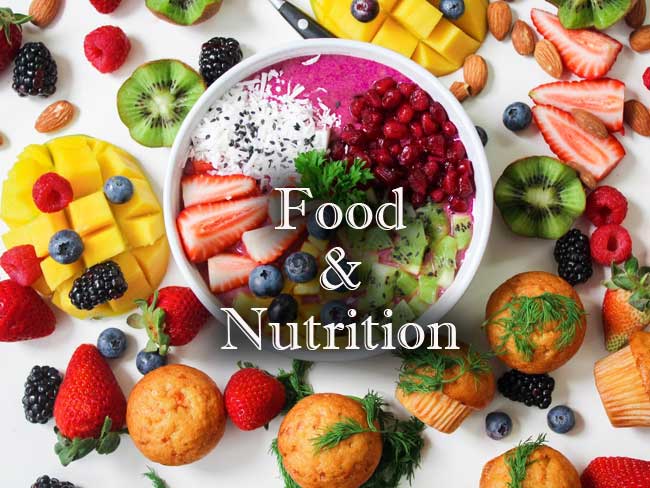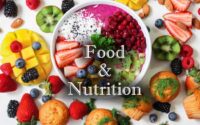Food and Nutrition Important Question
In this Article, we have provided the Food and Nutrition Important Question Papers along with Solutions. So, the interested candidates who applied for jobs in Food and Nutrition can download Food and Nutrition Important Question Papers for free of cost. Get all the Food and Nutrition Important Question Papers with just one click.

Click on the enclosed links below to download the Food and Nutrition Important Question Papers. Check the Last five years Food and Nutrition Important Question Papers to get a clear idea of the exam pattern. Along with Food and Nutrition Important Question Papers, it’s better to refer Food and Nutrition Syllabus & Exam Pattern before starting preparation. So, click on link to check and download Food and Nutrition Important Question Papers PDF.
Important Question Papers on Food and Nutrition
1. Maillard reaction takes place when protein is cooked for a prolonged period of time with
(1) Sugar
(2) Vitamins
(3) Minerals
(4) Antioxidants
2. What does HACCP stand for ?
(1) Hazard Analysis and Critical Control Point
(2) Hazard and Critical Control Point
(3) Health Analysis and Critical Control Point
(4) Hazard and Critical Cooking a Point
3. About 97 percent dietary lipids are present in the form of
(1) Phospholipids
(2) Triglycerides
(3) Cholesterol
(4) Glycerol
4. What is the primary reason for blanching food ?
(1) Cleans the food.
(2) Prevents pest infestation.
(3) Inactivates enzymes in food.
(4) Prevents food from drying.
5. As per the report of expert group (CMR-NIN, 2020) calcium requirements for a pregnant woman is
(1) 1000 mg/day
(2) 1050 mg/day
(3) 1100 mg/day
(4) 1200 mg/day
6. Computation of energy requirement for an adult is based on
(1) Factorial Approach
(2) Nutrient turnover
(3) Nutrient balance
(4) Dietary intake
7. As per the ICMR-NIN 2020 the age for Reference Indian Adult Male and Female has been mentioned in the definition is
(1) 19-39 years
(2) 20-39 years
(3) 19-40 years
(4) 20-40 years
8. In which organ of the body β-carotene changes to retinol ?
(1) Liver
(2) Pancreas
(3) Gall Bladder
(4) Intestine
9. Arrange the right sequence in decreasing order of protein content in food :
A. Bread
B. Cheese
C. Butter
D. Boiled egg
Codes:
(1) A B C D
(2) B C D A
(3) C A B D
(4) D B A C
10. Give the sequential involvement of enzymes for the digestion of food in the gastro-intestinal tract :
A. Iso-maltase
B. Pepsin
C. Ptylin
D. Amylase
Codes :
(1) A B D C
(2) C B D A
(3) D A B C
(4) B A C D
11. Arrange the following foods in ascending order of their iron content :
A. Egg
B. Leafy vegetables
C. Liver
D. Milk
Codes:
(1) D B A C
(2) C A B D
(3) C B D A
(4) A C D B
12. Given below are two statements, one is labelled as Assertion (A) and the other is labelled as Reason (R).
Assertion (A) : Consumption of plenty of fruits and vegetables protects individuals from certain cancers.
Reason (R) : The antioxidants present in fruits and vegetables help in removal of free radials.
Codes :
(1) Both (A) and (R) are false.
(2) Both (A) and (R) are true.
(3) (A) is true, (R) is false.
(4) (A) is false, (R) is true.
13. Arrange in the correct sequence of the symptoms of diabetes as they appear with advancement of disease :
A. Dehydration
B. Glycosuria
C. Polyurea
D. Ketosis
E. Hyperglycemia
F. Dhiabetic coma
Codes :
(1) E C B D A F
(2) E B C A D F
(3) B A C E F D
(4) C B A D E F
14. Put the following foods in increasing order of their calcium content :
A. Bengal gram dal
B. Milk
C. Spinach
D. Almond
Codes :
(1) B D C A
(2) D B A C
(3) C B A D
(4) A C B D
15. Which of the following foods are rich in Omega-3 fatty acids ?
A. Lard
B. Butter
C. Fatty fish
D. Mustard seeds
E. Walnut
Codes :
(1) A D and E
(2) C, D and E
(3) A, C and E
(4) B,C and D
16. The three main Omega-3 fatty acids are
A. Alpha-linolenic acid
B. Butyric acid
C. Eicosapenataenoic acid
D. Docosahexaenoic acid
E. Palmitic acid
F. Stearic acid
Codes :
(1) A, B and C
(2) A, C and E
(3) B, C and D
(4) A, C and D
17. Infants born to mothers who are vegan may be at increased risk of deficiency of which nutrient ?
(1) Vitamin C
(2) Folate
(3) Vitamin B12
(4) Calcium
18. The iron requirement during pregnancy and lactation as per ICMR-NIN, 2020 is”
(1) 27 mg/d and 23 mg/d
(2) 23 mg/d and 29 me/d
(3) 29 mg/d and 32 mg/d
(4) 32 mg/d and 27 mg/d
19. The additional protein requirement in 3% trimester of pregnancy as per ICMR-NIN, 2020 is –
(1) 22 g/day
(2) 17 g/day
(3) 18 g/day
(4) 9.5 g/day
20. Physical Activity Level (PAL) values for Indian reference adult man doing moderate work (ICMR-2010) is
(1) 1.5
(2) 1.7
(3) 1.8
(4) 1.9
| Practice Papers | Quiz |
| Easy Question | Previous Question |
| Difficult Question | Sample Papers |
| Important Question | Model Papers |
| GK | Food Safety |
| MCQs |
21. High Blood Pressure and the presence of protein in the urine during pregnancy may be signs of
(1) Preeclampsia
(2) Hyperemesis
(3) Goitre
(4) Gestational diabetes
22. A condition of severe and persistent vomiting during pregnancy is called
(1) Hyperemesis gravidarum
(2) Placenta previa
(3) Diabetes
(4) Eclampsia
23. A pregnant woman’s energy needs must be met in order to
(1) Spare vitamins
(2) Spare adipose stores
(3) Prevent foetal deformity
(4) Spare protein
24. Iron needs increase during pregnancy because of
(1) Constipation
(2) Increase blood volume
(3) Increased maternal metabolic rate
(4) Poor iron absorption during pregnancy
25. During pregnancy, which of the following hormones is present in the urine of the mother ?
(1) Progesterone
(2) Luteinising Hormone
(3) Follicle Stimulating Hormone
(4) Human Chorionic Gonadotropix Hormone
26. The enzyme enterokinase helps in the conversion of
(1) Trypsinogen into trypsin
(2) Caseinogen into casein
(3) Pepsinogen into pepsin
(4) Protein into polypeptides
27. The intrinsic factor that helps in the absorption of Vitamin B12 is secreted by
(1) Parietal cells
(2) Hepatic cells
(3) Oxyntic cells
(4) Chief cells
28. Which of the following statements is true ?
(1) Prolactin from the anterior pituitary stimulates milk production
(2) Prolactin from the posterior pituitary stimulates milk production
(3) Oxytocin from the posterior pituitary stimulates milk production
(4) Oxytocin from the anterior pituitary stimulates milk production
29. The body weight of reference Indian adult man (CMR-NIN, 2020) is.
(1) 50 kg
(2) 55 kg
(3) 60 kg
(4) 65kg
30. As per ICMR-NIN, 2020 recommendations for fibre based on energy intake is
(1) 10 g/1000 kcal
(2) 15 g/2000 kcal
(3) 20 g/1000 kcal
(4) 30 g/2000 kcal
31. The recommended estimated energy requirements (CMR-NIN 2020) based on BMR and physical activity levels for sedentary elderly woman weighing 55 kg is
(1) 1500 kcal
(2) 1600 kcal
(3) 1700 kcal
(4) 1800 kcal
32. Acceptable carbohydrate distribution range of lactating women as percent of energy is (ICMR-NIN, 2020)
(1) 45-65%
(2) 50-70%
(3) 55-75%
(4) 60-80%
33. Recommended dietary allowances of niacin for moderate working women is ICMR-NIN, 2020)
(1) 11 mg/day
(2) 14 mg/day
(3) 18 mg/day
(4) 20 mg/day
34. Which of the following is the most common symptom of myocardial infarction ?
(1) Chest pain
(2) Dyspnoea
(3) Edema
(4) Palpitations
35. Which of the following risk factors for coronary artery disease cannot be corrected ?
(1) Cigarette smoking
(2) Obesity
(3) Heredity
(4) Hypertension
36. Presence of RBC in urine is known as
(1) Proteinuria
(2) Hematuria
(3) Urolithiasis
(4) Nephritis
37. HDL is synthesized and secreted from
(1) Pancreas
(2) Liver
(3) Kidneys
(4) Muscles
38. From which plant source is gluten derived ?
(1) Soya
(2) Rice
(3) Corn
(4) Wheat
39. Condition in which unabsorbed fat remains in the stool is known as
(1) Diarrhoea
(2) Steatorrhoea
(3) Cholecystitis
(4) Colitis
40. When the food is directly given in the veins, it is called as
(1) Parenteral nutrition
(2) Enteral nutrition
(3) Nasogastric nutrition
(4) Saline nutrition
41. Cancer of the blood cells is referred to as
(1) Kaposi Sarcoma
(2) Basal Cell Carcinoma
(3) Mesothelioma
(4) Leukemia
42. Which of the following is not a symptom of lactose intolerance ?
(1) Bloating
(2) Stomach Cramps
(3) Nausea
(4) Fever
43. Another word for gallstone disease is
(1) Cholelithiasis
(2) Cholecystitis
(3) Urolithiasis
(4) Hepatitis
44. Given below are two statements, one is labelled as Assertion (A) and the other is labelled as Reason (R).
Assertion (A) : Estrogen causes more cholesterol to be secreted in the bile and is therefore associated with a high prevalence of gallstones.
Reason (R): Women on hormone replacement therapy are more prone to the development of gallstones.
Codes :
(1) Both (A) and (R) are correct and (R) is the correct explanation of Assertion (A).
(2) Both (A) and (R) are correct but (R) is not the correct explanation of Assertion (A).
(3) (A) is correct but (R) is not correct.
(4) (A) is not correct but (R) is correct.
45. Which nutrients is key for supplying the body with energy ?
(1) Protein
(2) Micronutrients
(3) Fibre
(4) Carbohydrate
46. What type of fat should make up the majority of fat intake for a healthy diet ?
(1) Saturated fat
(2) Unsaturated fat
(3) Fat from animal products
(4) Trans fats
47. What is one lifestyle change that can be used to treat Phenylketonuria ?
(1) Eating mostly carbohydrates with limited protein.
(2) Eating mostly protein to replace the lost phenylalanine.
(3) Eating a balanced diet of protein and carbohydrates and fats.
(4) Getting plenty of exercise to burn off the extra phenylalanine.
48. What type of diet is recommended for weight maintenance ?
(1) Low protein and low Glycaemic Index
(2) High protein and high Glycaemic Index
(3) Low protein and high Glycaemic Index
(4) High protein and low Glycaemic Index
49. Burns are classified by degrees from first to third. Which of these describes a third-degree burn ?
(1) Burned area is larger than inches across.
(2) Burned area is on the face.
(3) Burned area covers 10% of the body.
(4) Burn extends through all the skin layers and tissue.
50. Which of the following enzymes is defective in galactosemia a fatal genetic disorder in infants ?
(1) Glucokinase
(2) Galactokinase
(3) UDP-Galactose 4-Epimerase
(4) Galactose-1-Phosphate Uridyltransferase

